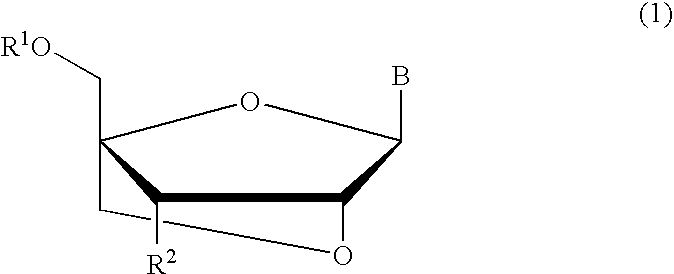Bicyclonucleoside analogues
a technology of bicyclonucleoside and analogues, which is applied in the field of new bicyclonucleoside analogues, can solve the problems of unsatisfactory non-natural oligonucleotide analogues described above, compounds that exhibit anti-aids activity, and unsatisfactory ones
- Summary
- Abstract
- Description
- Claims
- Application Information
AI Technical Summary
Benefits of technology
Problems solved by technology
Method used
Image
Examples
example 1
3′-Azido-5′O-tert-butyldiphenylsilyl-3′-deoxy-2′-0,4′-C-methyl ene-5-methyluridine
Exemplification Compound Number 2–48
[0311]Potassium carbonate (41 mg, 0.29 mmol) was added to a methanol solution (7 ml) of the compound obtained in Reference example 5 (200 mg, 0.27 mmol) at 0° C. and the mixture was stirred for 4.5 hrs at room temperature. Further potassium carbonate (34 mg, 0.25 mmol) was added to the mixture, which was stirred for 23 hrs. After the methanol was evaporated, the residue was partitioned between ethyl acetate and water. The extract was washed with saturated aqueous sodium chloride solution. The organic phase was dried over anhydrous sodium sulfate. The solvents were evaporated and the residue was purified by silica gel column chromatography (ethyl acetate:n-hexane=2:1) to give the title compound as colorless crystals (142 mg, 0.27 mmol, 100%).
[0312]mp 93–95° C. IR νmax (KBr): 3169, 3047, 2956, 2888, 2859, 2117, 1696, 1275, 1109 1H-NMR (CDCl3) δ: 1.12 (9H, s), 1.65 (3...
example 2
3′-Azido-3′-deoxy-2′-O,4′-C-methylene-5-methyluridine
Exemplification Compound Number 2–14
[0313]Anhydrous tetrabutylammonium fluoride (10 M in THF, 290 μl, 0.29 mmol) was added to an anhydrous tetrahydrofuran solution (5 ml) of the compound obtained in Example 1 (140 mg, 0.26 mmol) in a stream of nitrogen gas and the solution was stirred for 1 hr at room temperature. The solvent was evaporated and the residue was purified by silica gel column chromatography (ethyl acetate:n-hexane=25:1) and the title compound was obtained as a white powder (65.7 mg, 0.22 mmol, 85%).
[0314]mp 94–96° C.
[0315]IR νmax (KBr): 3163, 3046, 2118, 1692, 1468, 1273, 1062 cm−1. 1H-NMR (CD3OD) δ: 1.89 (3H, s), 3.76, 3.86 (2H, AB, J=8 Hz), 3.85, 3.95 (2H, AB, J=13 Hz), 4.03 (1H, s), 4.58 (1H, s), 5.58 (1H, s), 7.70 (1H, s). 13C-NMR (CD3OD) δ: 12.8, 57.3, 61.2, 72.4, 79.8, 88.3, 91.0, 110.8, 136.3, 151.5, 166.1.
example 3
3′-Amino-3′-deoxy-2′-0,4′-C-methylene-5-methyluridine
Exemplification Compound Number 2–4
[0316]An ethanol solution (3 ml) of the compound obtained in Example 2 (64 mg, 0.22 mmol) was added to 10% palladium-carbon (28 mg) suspended in anhydrous tetrahydrofuran solution (5 ml) in a stream of hydrogen gas, and the mixture was stirred for 0.5 hr at room temperature. The reaction mixture was filtered and the solvent of the filtrate was evaporated and the title compound was obtained as a white powder (59 mg, 0.22 mmol, 100%).
[0317]mp 243–246° C. IR νmax (KBr): 3459, 3365, 1699, 1447, 1273, 1054 cm−1. 1H-NMR (C5D5N) δ: 1.83 (3H, s), 3.62 (1H, s), 3.92, 4.14 (2H, AB, J=8 Hz), 4.24 (2H, s), 4.54 (1H, s), 5.97 (1H, s), 7.90 (1H, s). 13C-NMR (C5D5N) δ: 12.8, 54.2, 57.2, 71.6, 81.4, 91.1, 109.5, 150.8, 164.3.
PUM
| Property | Measurement | Unit |
|---|---|---|
| Mass | aaaaa | aaaaa |
| Fraction | aaaaa | aaaaa |
| Fraction | aaaaa | aaaaa |
Abstract
Description
Claims
Application Information
 Login to View More
Login to View More - R&D
- Intellectual Property
- Life Sciences
- Materials
- Tech Scout
- Unparalleled Data Quality
- Higher Quality Content
- 60% Fewer Hallucinations
Browse by: Latest US Patents, China's latest patents, Technical Efficacy Thesaurus, Application Domain, Technology Topic, Popular Technical Reports.
© 2025 PatSnap. All rights reserved.Legal|Privacy policy|Modern Slavery Act Transparency Statement|Sitemap|About US| Contact US: help@patsnap.com



